

We started with this smoked bluefish spread on a bagel, and then dove into the whole smoked fish. All photography by Dhanraj Emanuel.
|
KAREN HOCHMAN is Editorial Director of THE NIBBLE.
|
|
September 2007
|
 |
Nantucket Wild Gourmet & Smokehouse
Line-Caught, Sustainable Seafood
CAPSULE REPORT: With a greater demand for seafood than the ocean can supply, and the impact of some commercial fishing methods on ecosystems, environmentally-sensitive consumers are seeking sustainable seafood choices. You can read more about the issues here. Nantucket Wild Gourmet & Smokehouse is dedicated to sustainable seafood, offering line-caught fish that are smoked in small batches using artisan methods. The line is certified kosher.
There’s a lot of smoked salmon out there, but Nantucket Wild Gourmet & Smokehouse is dedicate to sustainable seafood. You can feel especially good that the fish are caught by members of the Hook Fisherman’s Association, whose goal is fish sustainability. All of the seafood is really wild—not farmed—and line caught by fisherman who have personal relationships with the company. What does line caught mean? It’s as if you were on a fishing trip: A fish bites, you reel it in, remove it by hand and gently place it down. It isn’t a mass operation, trawling for fish with nets, hauling in hundreds of thrashing fish and dumping them in a hold. Line-caught fish are placed into foam so they aren’t gasping for breath; they aren’t thrown and dropped, they don’t get bruised. They’re treated humanely.
Cold Smoking & Processing
Nantucket Wild Gourmet & Smokehouse products are cold smoked. Hot smoked or cold smoked: What’s the difference? Hot smoking basically cooks the fish at a higher temperature—the texture is as it would be if you cooked it at home. Cold smoking is slow-smoking at a low temperature; it leaves a translucency and more moisture in the flesh.
Each fish is treated individually. With farmed fish, there’s consistency in dimensions and weight. It’s easy to throw 40 fish into a brine and smoke those fish for the same amount of time. With wild fish, the size and weight vary substantially; with each fish, it’s an art to decide how much salt is needed, how long it gets smoked. This is small-batch handling—six to eight fish at a time. Fortunately, NWG&S has a state of the art smokehouse, built two years ago, to help them with the arduous task.
But the result of smoking wild-caught fish, fish by individual fish, is that each fish will taste different. Farm-raised fish all eat the same food and they all taste the same; consistency is the name of the game. Wild fish are a radically different experience—their taste reflects what they’ve eaten wild, each one will taste different (In fact, we had two shipments of Alaskan King Salmon that looked and tasted like different species of salmon; the difference is that the darker, saltier-fleshed one had been dining on squid!).
Varieties Of Smoked Fish
It’s a veritable buffet of smoked fish. The fish have a month shelf life in the refrigerator; they can be frozen and thawed in the refrigerator or microwave.
Cold Smoked Chatham Bluefish & Bluefish Salad
We also love bluefish—and this subtly-smoked bluefish is another way of enjoying it. (The bluefish are not solely cold-smoked: They spend 15 hours in cold smoke and the last few in hot smoke.)
The bluefish are caught off the coast of Cape Cod. In addition to the smoked bluefish filet, there’s a creamy and smoky bluefish salad, spread or dip. Made mostly from the smoked bluefish, it’s blended with cream cheese, sour cream, horseradish, fresh dill and onion. O.K., not the diet dish, but it’s is delicious on a bagel, as a filling in fennel stalks (the gourmet’s celery—or in celery stalks, if you prefer), and as a primary component of canapés—we added strips of roasted red pepper on top. |
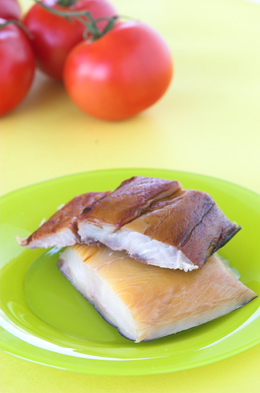
Smoked bluefish—not as pretty as the black cod, but just as tasty. |
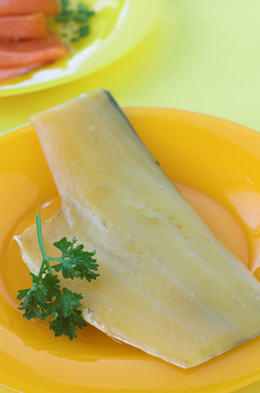
Smoked Haddock |
Cold Smoked Chatham Haddock
Nantucket Wild Gourmet & Smokehouse is located in Chatham, Massachusetts, on Cape Cod, and we can just imagine the Chatham haddock swimming right up and volunteering themselves for the smoker. While we loved the way this pretty, shiny yellow fish appeared on the plate, it wasn’t a good “eatin’ fish” but a cooking fish. While black cod, blue fish and salmon have oily flesh, haddock is a thin, dry white fish. Smoked, it’s not meant to be eaten on a plate or put on a bagel or canapé the way the others are. Rather, the salty filet is primarily used in cooking—for chowder, Finnan haddie,* fish cakes, etc.
*Smoked haddock named for the fishing village of Finnan or Findon, Scotland, where it was originally cold-smoked over peat. Finnan haddie is often served poached in milk for breakfast. |
Cold Smoked Wild Alaskan Black Cod (Sable)
The black cod, or sablefish, is one of those sea creatures that confuses people due to its multiple associates. It’s not a true cod (the Atlantic cod is Gadus morhua). The sablefish (Anoplopoma fimbria) that is called black cod isn’t even the real black cod (Notothenia microlepidota), which is a southern hemisphere icefish. Still, we’re not ichthyologists—we just like to eat a good piece of fish. Black cod/sablefish is not only good, it’s good for you: It has as many long-chain omega 3 fatty acids (EPA and DHA) as wild salmon, its Alaskan neighbor.
We love eating black cod, and our two favorite preparations are miso-baked black cod one day, to smoked black cod the next. When smoked, the texture of the fish changes—it becomes shiny and translucent and has a smooth texture that is different from all of the other fish. |
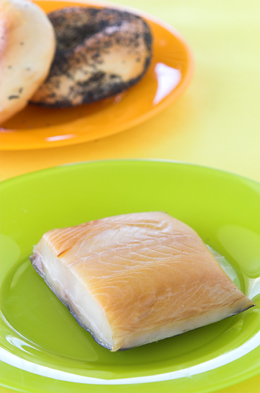
Smoked black cod (sablefish, or sable for short). |
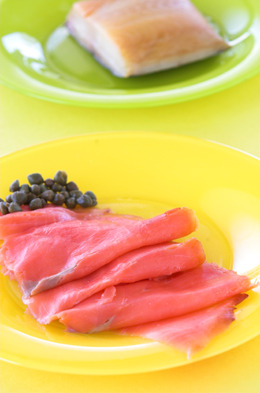
Smoked Wild King Salmon. This fellow ate lots of squid. |
Cold Smoked Wild King Salmon
The wild King Salmon, also known as the Chinook†, is the largest of the salmon species, approximately 20 pounds and 30 to 40 inches in length (it’s also the least abundant species). NWG&S’s salmon are fished in the deep waters of the Gulf of Alaska. The company advises to avoid river-caught fish (which have gone up-river to spawn): They’ve already used up all their omega 3s swimming upstream.
The King Salmon is distinguished by its red-orange flesh, rich flavor, high oil content and firm texture. We had two different packages, which showed how different each individual fish can be. One was vibrantly red-orange, with a stronger fish flavor; the other more pale, with somewhat sweeter flesh. The red-colored ones feed more on squid, we’re told. |
†The name of a nation of Native Americans that occupied the coast of the Pacific Northwest along the lower and middle Columbia River, in present-day Oregon and Washington, where the salmon were fished.
The company also smokes albacore tuna caught in New England waters.
Go wild: Try some wild, line-caught fish. And send some to your kosher friends for Rosh Hashanah.
NANTUCKET WILD GOURMET & SMOKEHOUSES
Wild, Line-Caught Smoked Fish
Certified kosher by Vaad Harabonim (Vaad Hakashrus) of Massachusetts
Prices shown per pound; other sizes available
- Smoked Chatham Bluefish
$25.00/Pound
- Smoked Chatham
Haddock
$22.50/Pound
- Wild Alaskan Smoked Black Cod
$30.00/Pound
- Wild Alaska King Smoked
Salmon
$80.00/Pound
Shop online at
NantucketWild.com
|
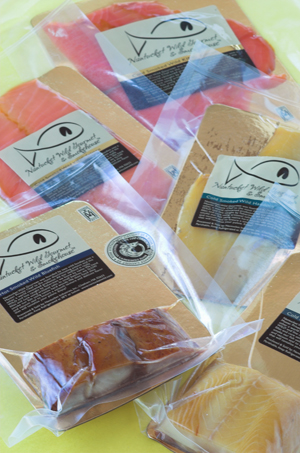
A family of fish. |
Note that as of this writing, only the smoked salmon is on the website. You can order the other products by telephone: 1.508.945.2700.
Prices and availability are verified at publication but are subject to change. Shipping is additional.
Lifestyle Direct, Inc. All rights reserved. Images are the copyright of their respective owners.

|









